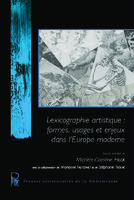Lexicographie artistique; Artistic lexicography
formes, usages et enjeux dans l’Europe moderne; forms, uses and issues in Early Modern Europe
Author(s)
Heck, Michèle-Caroline
Freyssinet , Marianne
Trouvé, Stéphanie
Collection
European Research Council (ERC); EU collectionLanguage
French; EnglishAbstract
In crossed approaches, the themes developed in this book bring a new look at the forms, uses and stakes of artistic lexicography in modern times.
In a perspective of circulation of concepts and practices, and permeability of the artistic borders, the word proves to be a precious laboratory of the practice of the artistic practice and a field of exploration of the cultural networks that cross and make Europe .
Through the development of a language, books on art whose publications are growing in the north of the Alps from 1600, aim at the construction of a common knowledge for the use of painters and amateurs.
Their many translations, published since the modern era, also testify to their role of diffusion agent in constant adaptation to the readership to which they are addressed. Understanding strategies and processes of invention and transfer of specific terminology to aesthetic expression becomes an important issue. Words, indeed, are not interchangeable. By succeeding or overlapping, even if they are contradictory, the different senses give thickness and subtlety to the concept.
The journey of a notion into time and space also contributes to broadening our understanding of a cultural history between universality and identity within the artistic diversity that characterizes modern Europe. Dans des approches croisées, les thématiques développées dans cet ouvrage apportent un regard neuf sur les formes, usages et enjeux de la lexicographie artistique à l’époque moderne.
Dans une perspective de circulation des concepts et des pratiques, et de perméabilité des frontières artistiques, le mot se révèle être un précieux laboratoire de l'exercice de la pratique artistique et un champ d'exploration des réseaux culturels qui traversent et font l’Europe.
À travers l'élaboration d'un langage, les livres sur l'art dont les publications se multiplient au Nord des Alpes à partir de 1600, visent à la construction d'un savoir commun à l'usage des peintres et des amateurs.
Leurs nombreuses traductions, publiées dès l'époque moderne, témoignent également de leur rôle d'agent de diffusion en constante adaptation au lectorat auquel ils s'adressent. Comprendre les stratégies et les processus d'invention et de transfert d’une terminologie spécifique à l’expression esthétique devient alors un enjeu important. Les mots, en effet, ne sont pas interchangeables. En se succédant ou se superposant, même s'ils sont contradictoires, les différents sens donnent épaisseur et subtilité au concept.
Le voyage d'une notion dans le temps et dans l'espace contribue alors aussi à un élargissement de notre compréhension d'une histoire culturelle entre universalité et identité au sein de la diversité artistique qui caractérise de l'Europe moderne.
Keywords
art theory; painting; artistic lexicography; artistic literature; artistic practice; artistic terminology; Giorgio Vasari; Giovanni Pietro Bellori; Karel van Mander; ParisDOI
10.26530/OAPEN_1000262ISBN
9782367812663OCN
1051776460Publisher website
https://www.pulm.fr/Publication date and place
Montpellier, 2018Grantor
Series
Théorie des Art,Classification
The Arts
Paintings and painting
Literacy


 Download
Download